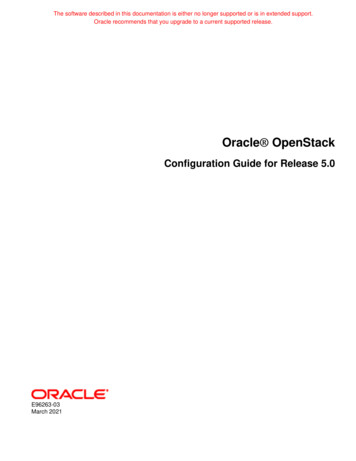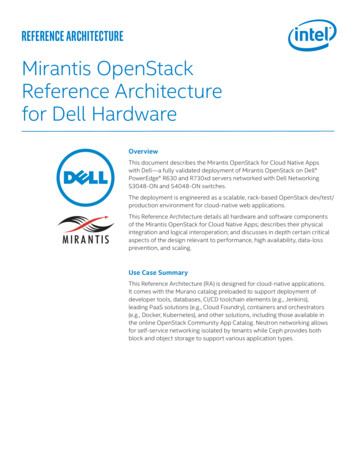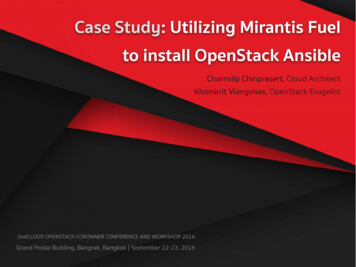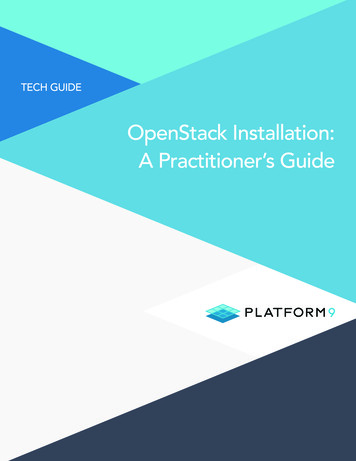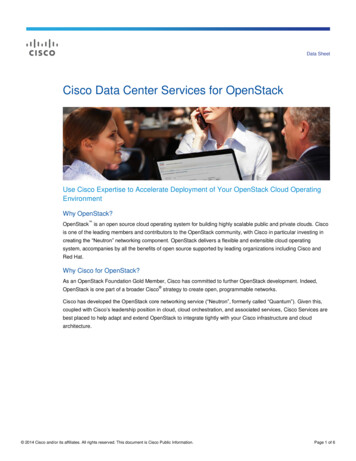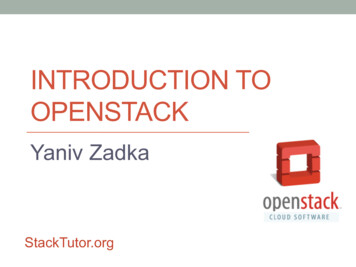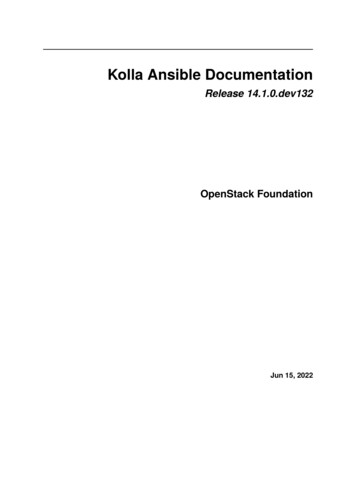
Transcription
Kolla Ansible DocumentationRelease 14.1.0.dev132OpenStack FoundationJun 15, 2022
CONTENTS1 Related Projects32 Site Notes53 Release Notes74 Administrator Guide4.1 Admin Guides . . . . . . . . . . . . . . . . . . . . . . . . . . . . . . . . . . . . . . .995 User Guide295.1 User Guides . . . . . . . . . . . . . . . . . . . . . . . . . . . . . . . . . . . . . . . . 296 Reference596.1 Projects Deployment Configuration Reference . . . . . . . . . . . . . . . . . . . . . . 597 Contributor Guide1977.1 Contributor Guide . . . . . . . . . . . . . . . . . . . . . . . . . . . . . . . . . . . . . 197i
ii
Kolla Ansible Documentation, Release 14.1.0.dev132Kollas mission is to provide production-ready containers and deployment tools for operating OpenStackclouds.Kolla Ansible is highly opinionated out of the box, but allows for complete customization. This permitsoperators with minimal experience to deploy OpenStack quickly and as experience grows modify theOpenStack configuration to suit the operators exact requirements.CONTENTS1
Kolla Ansible Documentation, Release 14.1.0.dev1322CONTENTS
CHAPTERONERELATED PROJECTSThis documentation is for Kolla Ansible.For information on building container images for use with Kolla Ansible, please refer to the Kolla imagedocumentation.Kayobe is a subproject of Kolla that uses Kolla Ansible and Bifrost to deploy an OpenStack control planeto bare metal.3
Kolla Ansible Documentation, Release 14.1.0.dev1324Chapter 1. Related Projects
CHAPTERTWOSITE NOTESThis documentation is continually updated and may not represent the state of the project at any specific prior release. To access documentation for a previous release of Kolla Ansible, append the OpenStack release name to the URL. For example, to access documentation for the Stein release: https://docs.openstack.org/kolla-ansible/stein5
Kolla Ansible Documentation, Release 14.1.0.dev1326Chapter 2. Site Notes
CHAPTERTHREERELEASE NOTESThe release notes for the project can be found asenotes/7
Kolla Ansible Documentation, Release 14.1.0.dev1328Chapter 3. Release Notes
CHAPTERFOURADMINISTRATOR GUIDE4.1 Admin Guides4.1.1 Advanced ConfigurationEndpoint Network ConfigurationWhen an OpenStack cloud is deployed, the REST API of each service is presented as a series of endpoints.These endpoints are the admin URL, the internal URL, and the external URL.Kolla offers two options for assigning these endpoints to network addresses: - Combined - Where all threeendpoints share the same IP address - Separate - Where the external URL is assigned to an IP addressthat is different than the IP address shared by the internal and admin URLsThe configuration parameters related to these options are: - kolla internal vip address - network interface - kolla external vip address - kolla external vip interfaceFor the combined option, set the two variables below, while allowing the other two to accept their default values. In this configuration all REST API requests, internal and external, will flow over the samenetwork.kolla internal vip address: "10.10.10.254"network interface: "eth0"For the separate option, set these four variables. In this configuration the internal and external REST APIrequests can flow over separate networks.kolla internal vip address: "10.10.10.254"network interface: "eth0"kolla external vip address: "10.10.20.254"kolla external vip interface: "eth1"9
Kolla Ansible Documentation, Release 14.1.0.dev132Fully Qualified Domain Name ConfigurationWhen addressing a server on the internet, it is more common to use a name, like www.example.net,instead of an address like 10.10.10.254. If you prefer to use names to address the endpoints in yourkolla deployment use the variables: kolla internal fqdn kolla external fqdnkolla internal fqdn: inside.mykolla.example.netkolla external fqdn: mykolla.example.netProvisions must be taken outside of kolla for these names to map to the configured IP addresses. Usinga DNS server or the /etc/hosts file are two ways to create this mapping.RabbitMQ Hostname ResolutionRabbitMQ doesnt work with IP address, hence the IP address of api interface should be resolvableby hostnames to make sure that all RabbitMQ Cluster hosts can resolve each others hostname beforehand.TLS ConfigurationConfiguration of TLS is now covered here.OpenStack Service Configuration in KollaAn operator can change the location where custom config files are read from by editing /etc/kolla/globals.yml and adding the following line.# The directory to merge custom config files the kolla's config filesnode custom config: "/etc/kolla/config"Kolla allows the operator to override configuration of services. Kolla will generally look for a filein /etc/kolla/config/ config file , /etc/kolla/config/ service name / config file or /etc/kolla/config/ service name / hostname / configfile , but these locations sometimes vary and you should check the config task in the appropriateAnsible role for a full list of supported locations. For example, in the case of nova.conf the following locations are supported, assuming that you have services using nova.conf running on hosts calledcontroller-0001, controller-0002 and controller-0003: /etc/kolla/config/nova.conf /etc/kolla/config/nova/controller-0001/nova.conf /etc/kolla/config/nova/controller-0002/nova.conf /etc/kolla/config/nova/controller-0003/nova.conf /etc/kolla/config/nova/nova-scheduler.confUsing this mechanism, overrides can be configured per-project, per-project-service or per-projectservice-on-specified-host.10Chapter 4. Administrator Guide
Kolla Ansible Documentation, Release 14.1.0.dev132Overriding an option is as simple as setting the option under the relevant section. For example, toset override scheduler max attempts in nova scheduler, the operator could create /etc/kolla/config/nova/nova-scheduler.conf with content:[DEFAULT]scheduler max attempts 100If the operator wants to configure compute node cpu and ram allocation ratio on host myhost, the operatorneeds to create file /etc/kolla/config/nova/myhost/nova.conf with content:[DEFAULT]cpu allocation ratio 16.0ram allocation ratio 5.0This method of merging configuration sections is supported for all services using Oslo Config, whichincludes the vast majority of OpenStack services, and in some cases for services using YAML configuration. Since the INI format is an informal standard, not all INI files can be merged in this way. In thesecases Kolla supports overriding the entire config file.Additional flexibility can be introduced by using Jinja conditionals in the config files. For example, youmay create Nova cells which are homogeneous with respect to the hypervisor model. In each cell, youmay wish to configure the hypervisors differently, for example the following override shows one way ofsetting the bandwidth poll interval variable as a function of the cell:[DEFAULT]{% if 'cell0001' in group names %}bandwidth poll interval 100{% elif 'cell0002' in group names %}bandwidth poll interval -1{% else %}bandwidth poll interval 300{% endif %}An alternative to Jinja conditionals would be to define a variable for the bandwidth poll intervaland set it in according to your requirements in the inventory group or host vars:[DEFAULT]bandwidth poll interval {{ bandwidth poll interval }}Kolla allows the operator to override configuration globally for all services. It will look for a file called/etc/kolla/config/global.conf.For example to modify database pool size connection for all services, the operator needs to create /etc/kolla/config/global.conf with content:[database]max pool size 1004.1. Admin Guides11
Kolla Ansible Documentation, Release 14.1.0.dev132OpenStack policy customisationOpenStack services allow customisation of policy. Since the Queens release, default policy configurationis defined within the source code for each service, meaning that operators only need to override rulesthey wish to change. Projects typically provide documentation on their default policy configuration, forexample, Keystone.Policy can be customised via JSON or YAML files. As of the Wallaby release, the JSON format isdeprecated in favour of YAML. One major benefit of YAML is that it allows for the use of comments.For example, to customise the Neutron policy in YAML format, the operator should add the customisedrules in /etc/kolla/config/neutron/policy.yaml.The operator can make these changes after services have been deployed by using the following command:kolla-ansible deployIn order to present a user with the correct interface, Horizon includes policy for other services. Customisations made to those services may need to be replicated in Horizon. For example, to customise theNeutron policy in YAML format for Horizon, the operator should add the customised rules in /etc/kolla/config/horizon/neutron policy.yaml.IP Address Constrained EnvironmentsIf a development environment doesnt have a free IP address available for VIP configuration, the hosts IPaddress may be used here by disabling HAProxy by adding:enable haproxy: "no"Note this method is not recommended and generally not tested by the Kolla community, but includedsince sometimes a free IP is not available in a testing environment.In this mode it is still necessary to configure kolla internal vip address, and it should take the IPaddress of the api interface interface.External Elasticsearch/Kibana environmentIt is possible to use an external Elasticsearch/Kibana environment. To do this first disable the deploymentof the central logging.enable central logging: "no"Now you can use the parameter elasticsearch address to configure the address of the external Elasticsearch environment.12Chapter 4. Administrator Guide
Kolla Ansible Documentation, Release 14.1.0.dev132Non-default service portIt is sometimes required to use a different than default port for service(s) in Kolla. It is possible withsetting service port in globals.yml file. For example:database port: 3307As service port value is saved in different services configuration so its advised to make abovechange before deploying.Use an external Syslog serverBy default, Fluentd is used as a syslog server to collect Swift and HAProxy logs. When Fluentd isdisabled or you want to use an external syslog server, You can set syslog parameters in globals.ymlfile. For example:syslog server: "172.29.9.145"syslog udp port: "514"You can also set syslog facility names for Swift and HAProxy logs. By default, Swift and HAProxy uselocal0 and local1, respectively.syslog swift facility: "local0"syslog haproxy facility: "local1"If Glance TLS backend is enabled (glance enable tls backend), the syslog facility for the glance tls proxy service uses local2 by default.This can be set viasyslog glance tls proxy facility.If Neutron TLS backend is enabled (neutron enable tls backend), the syslog facility for the neutron tls proxy service uses local4 by default.This can be set viasyslog neutron tls proxy facility.Mount additional Docker volumes in containersIt is sometimes useful to be able to mount additional Docker volumes into one or more containers. Thismay be to integrate 3rd party components into OpenStack, or to provide access to site-specific data suchas x.509 certificate bundles.Additional volumes may be specified at three levels: globally per-service (e.g. nova) per-container (e.g. nova-api)To specify additional volumes globally for all containers, set default extra volumes in globals.yml. For example:default extra volumes:- "/etc/foo:/etc/foo"4.1. Admin Guides13
Kolla Ansible Documentation, Release 14.1.0.dev132To specify additional volumes for all containers in a service, set service name extra volumes inglobals.yml. For example:nova extra volumes:- "/etc/foo:/etc/foo"To specify additional volumes for a single container, set container name extra volumes inglobals.yml. For example:nova libvirt extra volumes:- "/etc/foo:/etc/foo"4.1.2 TLSThis guide describes how to configure Kolla Ansible to deploy OpenStack with TLS enabled. EnablingTLS on the provided internal and/or external VIP address allows OpenStack clients to authenticate andencrypt network communication with OpenStack services.When an OpenStack service exposes an API endpoint, Kolla Ansible will configure HAProxy for thatservice to listen on the internal and/or external VIP address. The HAProxy container load-balancesrequests on the VIPs to the nodes running the service container.There are two different layers of TLS configuration for OpenStack APIs:1. Enabling TLS on the internal and/or external VIP, so communication between an OpenStack clientand the HAProxy listening on the VIP is secure.2. Enabling TLS on the backend network, so communication between HAProxy and the backend APIservices is secure.Note: TLS authentication is based on certificates that have been signed by trusted Certificate Authorities.Examples of commercial CAs are Comodo, Symantec, GoDaddy, and GlobalSign. Letsencrypt.org is aCA that will provide trusted certificates at no charge. If using a trusted CA is not possible for your project,you can use a private CA, e.g. Hashicorp Vault, to create a certificate for your domain, or see Generatinga Private Certificate Authority to use a Kolla Ansible generated private CA.For details on ACME-enabled CAs, such as letsencrypt.org, please see ACME http-01 challenge support.Quick StartNote: The certificates generated by Kolla Ansible use a simple Certificate Authority setup and are notsuitable for a production deployment. Only certificates signed by a trusted Certificate Authority shouldbe used in a production deployment.To deploy OpenStack with TLS enabled for the external, internal and backend APIs, configure the following in globals.yml:kolla enable tls internal: "yes"kolla enable tls external: "yes"(continues on next page)14Chapter 4. Administrator Guide
Kolla Ansible Documentation, Release 14.1.0.dev132(continued from previous page)kolla enable tls backend: "yes"kolla copy ca into containers: "yes"If deploying on Debian or Ubuntu:openstack cacert: "/etc/ssl/certs/ca-certificates.crt"If on CentOS or RHEL:openstack cacert: "/etc/pki/tls/certs/ca-bundle.crt"The Kolla Ansible certificates command generates a private test Certificate Authority, and then usesthe CA to sign the generated certificates for the enabled VIP(s) to test TLS in your OpenStack deployment.Assuming you are using the multinode inventory:kolla-ansible -i /multinode certificatesTLS Configuration for internal/external VIPThe configuration variables that control TLS for the internal and/or external VIP are: kolla enable tls external kolla enable tls internal kolla internal fqdn cert kolla external fqdn certNote: If TLS is enabled only on the internal or external network, then kolla internal vip addressand kolla external vip address must be different.If there is only a single network configured in your topology (as opposed to separate internal and externalnetworks), TLS can only be enabled using the internal network configuration variables.The default state for TLS networking is disabled. To enable external TLS encryption:kolla enable tls external: "yes"To enable internal TLS encryption:kolla enable tls internal: "yes"Two certificate files are required to use TLS securely with authentication, which will be provided by yourCertificate Authority: server certificate with private key CA certificate with any intermediate certificatesThe combined server certificate and private key needs to be provided to Kolla Ansible, with thepath configured via kolla external fqdn cert or kolla internal fqdn cert. These pathsdefault to {{ kolla certificates dir }}/haproxy.pem and {{ kolla certificates dir4.1. Admin Guides15
Kolla Ansible Documentation, Release 14.1.0.dev132}}/haproxy-internal.pem respectively, where kolla certificates dir is /etc/kolla/certificates by default.If the server certificate provided is not already trusted by clients, then the CA certificate file will needto be distributed to the clients. This is discussed in more detail in Configuring the OpenStack Client forTLS and Adding CA Certificates to the Service Containers.Configuring the OpenStack Client for TLSThe location for the CA certificate for the admin-openrc.sh file is configured with thekolla admin openrc cacert variable, which is not set by default. This must be a valid path onall hosts where admin-openrc.sh is used.When TLS is enabled on a VIP, and kolla admin openrc cacert is set to /etc/pki/tls/certs/ca-bundle.crt, an OpenStack client will have settings similar to this configured by admin-openrc.sh:export OS PROJECT DOMAIN NAME Defaultexport OS USER DOMAIN NAME Defaultexport OS PROJECT NAME adminexport OS TENANT NAME adminexport OS USERNAME adminexport OS PASSWORD demoPasswordexport OS AUTH URL https://mykolla.example.net:5000export OS INTERFACE internalexport OS ENDPOINT TYPE internalURLexport OS MISTRAL ENDPOINT TYPE internalURLexport OS IDENTITY API VERSION 3export OS REGION NAME RegionOneexport OS AUTH PLUGIN password# os cacert is optional for trusted certificatesexport OS CACERT /etc/pki/tls/certs/ca-bundle.crtAdding CA Certificates to the Service ContainersTo copy CA certificate files to the service containers:kolla copy ca into containers: "yes"When kolla copy ca into containers is configured to yes, the CA certificate files in /etc/kolla/certificates/ca will be copied into service containers to enable trust for those CA certificates. This is required for any certificates that are either self-signed or signed by a private CA, and arenot already present in the service image trust store. Kolla will install these certificates in the containersystem wide trust store when the container starts.All certificate file names will have the kolla-customca- prefix prepended to them when they arecopied into the containers. For example, if a certificate file is named internal.crt, it will be namedkolla-customca-internal.crt in the containers.For Debian and Ubuntu containers, the certificate files will be copied to the /usr/local/share/ca-certificates/ directory.16Chapter 4. Administrator Guide
Kolla Ansible Documentation, Release 14.1.0.dev132For CentOS and RHEL containers, the certificate files will be copied to the /etc/pki/ca-trust/source/anchors/ directory.In both cases, valid certificates will be added to the system trust store - /etc/ssl/certs/ca-certificates.crt on Debian and Ubuntu, and /etc/pki/tls/certs/ca-bundle.crt on CentOS and RHEL.Configuring a CA bundleOpenStack services do not always trust CA certificates from the system trust store by default. To resolvethis, the openstack cacert variable should be configured with the path to the CA Certificate in thecontainer.To use the system trust store on Debian or Ubuntu:openstack cacert: /etc/ssl/certs/ca-certificates.crtFor CentOS or RHEL:openstack cacert: /etc/pki/tls/certs/ca-bundle.crtBack-end TLS ConfigurationEnabling TLS on the backend services secures communication between the HAProxy listing on the internal/external VIP and the OpenStack services. It also enables secure end-to-end communication betweenOpenStack services that support TLS termination. The OpenStack services that support backend TLS termination in Victoria are: Nova, Ironic, Neutron, Keystone, Glance, Heat, Placement, Horizon, Barbican,and Cinder.The configuration variables that control back-end TLS for service endpoints are: kolla enable tls backend kolla tls backend cert kolla tls backend key haproxy backend cacert haproxy backend cacert dirThe default state for back-end TLS is disabled. To enable TLS for the back-end communication:kolla enable tls backend: "yes"It is also possible to enable back-end TLS on a per-service basis. For example, to enable back-end TLSfor Keystone, set keystone enable tls backend to yes.The default values for haproxy backend cacert and haproxy backend cacert dir should sufficeif the certificate is in the system trust store. Otherwise, they should be configured to a location of the CAcertificate installed in the service containers.Each backend service requires a certificate and private key. In many cases it is necessary to use a separatecertificate and key for each host, or even per-service. The following precedence is used for the certificate:4.1. Admin Guides17
Kolla Ansible Documentation, Release 14.1.0.dev132 {{ kolla certificates dir }}/{{ inventory hostname }}/{{ project name}}-cert.pem {{ kolla certificates dir }}/{{ inventory hostname }}-cert.pem {{ kolla certificates dir }}/{{ project name }}-cert.pem {{ kolla tls backend cert }}And for the private key: {{ kolla certificates dir }}/{{ inventory hostname }}/{{ project name}}-key.pem {{ kolla certificates dir }}/{{ inventory hostname }}-key.pem {{ kolla certificates dir }}/{{ project name }}-key.pem {{ kolla tls backend key }}The default for kolla certificates dir is /etc/kolla/certificates.kolla tls backend certandkolla tls backend key,defaultto{{kolla certificates dir }}/backend-cert.pem and {{ kolla certificates dir }}/backend-key.pem respectively.project name is the name of the OpenStack service, e.g. keystone or cinder.Note: The back-end TLS cert/key can be the same certificate that is used for the VIP, as long as thosecertificates are configured to allow requests from both the VIP and internal networks.By default, the TLS certificate will be verified as trustable by the OpenStack services. Although notrecommended for production, it is possible to disable verification of the backend certificate:kolla verify tls backend: "no"Generating a Private Certificate AuthorityNote: The certificates generated by Kolla Ansible use a simple Certificate Authority setup and are notsuitable for a production deployment. Only certificates signed by a trusted Certificate Authority shouldbe used in a production deployment.Its not always practical to get a certificate signed by a trusted CA. In a development or internal testOpenStack deployment, it can be useful to generate certificates locally to enable TLS.For convenience, the kolla-ansible command will generate the necessary certificate files based onthe information in the globals.yml configuration file and the inventory file:kolla-ansible -i multinode certificatesThe certificates role performs the following actions:1. Generates a test root Certificate Authority2. Generates the internal/external certificates which are signed by the root CA.18Chapter 4. Administrator Guide
Kolla Ansible Documentation, Release 14.1.0.dev1323. If back-end TLS is enabled, generate the back-end certificate signed by the root CA.The combined certificate and key file haproxy.pem (which is the default value forkolla external fqdn cert) will be generated and stored in the /etc/kolla/certificates/ directory, and a copy of the CA certificate (root.crt) will be stored in the /etc/kolla/certificates/ca/ directory.Generating your certificates without kolla-ansibleIf you want to manage your TLS certificates outside kolla-ansible directly on your hosts, you can do itby setting kolla externally managed cert to true. This will make kolla-ansible ignore any copyof certificate from the operator to kolla-ansible managed hosts and will keep other configuration optionsfor TLS as is.If using this option, make sure that all certificates are present on the appropriate hosts in the appropriatelocation.4.1.3 ACME http-01 challenge supportThis guide describes how to configure Kolla Ansible to enable ACME http-01 challenge support. Asof Victoria, Kolla Ansible supports configuring HAProxy Horizon frontend to proxy ACME http-01challenge requests to selected external (not deployed by Kolla Ansible) ACME client servers. These canbe ad-hoc or regular servers. This guide assumes general knowledge of ACME.Do note ACME supports http-01 challenge only over official HTTP(S) ports, that is 80 (for HTTP) and443 (for HTTPS). Only Horizon is normally deployed on such port with Kolla Ansible (other servicesuse custom ports). This means that, as of now, running Horizon is mandatory to support ACME http-01challenge.How To (External ACME client)You need to determine the IP address (and port) of the ACME client server used for http-01 challenge(e.g. the host you use to run certbot). The default port is usually 80 (HTTP). Assuming the IP addressof that host is 192.168.1.1, the config would look like the following:enable horizon: "yes"acme client servers:- server certbot 192.168.1.1:80acme client servers is a list of HAProxy backend server directives. The first parameter is the nameof the backend server - it can be arbitrary and is used for logging purposes.After (re)deploying, you can proceed with running the client to host the http-01 challenge files. Pleaseensure Horizon frontend responds on the domain you request the certificate for.To use the newly-generated key-cert pair, follow the TLS guide.4.1. Admin Guides19
Kolla Ansible Documentation, Release 14.1.0.dev1324.1.4 MariaDB database backup and restoreKolla Ansible can facilitate either full or incremental backups of data hosted in MariaDB. It achieves thisusing Mariabackup, a tool designed to allow for hot backups - an approach which means that consistentbackups can be taken without any downtime for your database or your cloud.Note: By default, backups will be performed on the first node in your Galera cluster or on the MariaDB node itself if you just have the one. Backup files are saved to a dedicated Docker volume mariadb backup - and its the contents of this that you should target for transferring backups elsewhere.Enabling Backup FunctionalityFor backups to work, some reconfiguration of MariaDB is required - this is to enable appropriate permissions for the backup client, and also to create an additional database in order to store backup information.Firstly, enable backups via globals.yml:enable mariabackup: "yes"Then, kick off a reconfiguration of MariaDB:kolla-ansible -i INVENTORY reconfigure -t mariadbOnce that has run successfully, you should then be able to take full and incremental backups as describedbelow.Backup ProcedureTo perform a full backup, run the following command:kolla-ansible -i INVENTORY mariadb backupOr to perform an incremental backup:kolla-ansible -i INVENTORY mariadb backup --incrementalKolla doesnt currently manage the scheduling of these backups, so youll need to configure an appropriatescheduler (i.e cron) to run these commands on your behalf should you require regular snapshots of yourdata. A suggested schedule would be: Daily full, retained for two weeks Hourly incremental, retained for one dayBackups are performed on your behalf on the designated database node using permissions defined duringthe configuration step; no password is required to invoke these commands.Furthermore, backup actions can be triggered from a node with a minimal installation of Kolla Ansible,specifically one which doesnt require a copy of passwords.yml. This is of note if youre looking toimplement automated backups scheduled via a cron job.20Chapter 4. Administrator Guide
Kolla Ansible Documentation, Release 14.1.0.dev132Restoring backupsOwing to the way in which Mariabackup performs hot backups, there are some steps that must be performed in order to prepare your data before it can be copied into place for use by MariaDB. This processis currently manual, but the Kolla Mariabackup image includes the tooling necessary to successfullyprepare backups. Two examples are given below.FullFor a full backup, start a new container using the Mariabackup image with the following options on thefirst database node:docker run --rm -it --volumes-from mariadb --name dbrestore \--volume mariadb backup:/backup ver:master \/bin/bash(dbrestore) cd /backup(dbrestore) rm -rf /backup/restore(dbrestore) mkdir -p /backup/restore/full(dbrestore) gunzip mysqlbackup-04-10-2018.qp.xbc.xbs.gz(dbrestore) mbstream -x -C /backup/restore/full/ mysqlbackup-04-10-2018., qp.xbc.xbs(dbrestore) mariabackup --prepare --target-dir /backup/restore/fullStop the MariaDB instance on all nodes:kolla-ansible -i multinode stop -t mariadb --yes-i-really-really-mean-itDelete the old data files (or move them elsewhere), and copy the backup into place, again on the firstnode:docker run --rm -it --volumes-from mariadb --name dbrestore \--volume mariadb backup:/backup ver:master \/bin/bash(dbrestore) rm -rf /var/lib/mysql/*(dbrestore) rm -rf /var/lib/mysql/\.[ \.]*(dbrestore) mariabackup --copy-back --target-dir /backup/restore/fullThen you can restart MariaDB with the restored data in place.For single node deployments:docker start mariadbdocker logs mariadb81004 15:48:27 mysqld safe WSREP: Running position recovery with --log error , '/var/lib/mysql//wsrep recovery.BDTAm8' --pid-file '/var/lib/mysql//scratch, recover.pid'181004 15:48:30 mysqld safe WSREP: Recovered position 9388319e-c7bd-11e8-b2ce, 6e9ec70d9926:584.1. Admin Guides21
Kolla Ansible Documentation, Release 14.1.0.dev132For multinode deployment restores, a MariaDB recovery role should be run, pointing to the first node ofthe cluster:kolla-ansible -i multinode mariadb recovery -e mariadb recover inventory, name controller1The above procedure is valid also for a disaster recovery scenario. In such case, first copy MariaDBbackup file from the external source into mariadb backup volume on the first node of the cluster. Fromthere, use the same steps as mentioned in the procedure above.IncrementalThis starts off similar to the full backup restore procedure above, but we must apply the logs from theincremental backups first of all before doing the final preparation required prior to restore. In the example below, I have a full backup - mysqlbackup-06-11-2018-1541505206.qp.xbc.xbs, and anincremental backup, p.xbc.xbs.docker run --rm -it --volumes-from mariadb --name dbrestore \--volume mariadb backup:/backup --tmpfs /backup/restore \quay.io/openstack.kolla/centos-sourc
Kolla Ansible Documentation, Release 14.1.0.dev114 Fully Qualified Domain Name Configuration When addressing a server on the internet, it is more common to use a name, like www.example.net,

